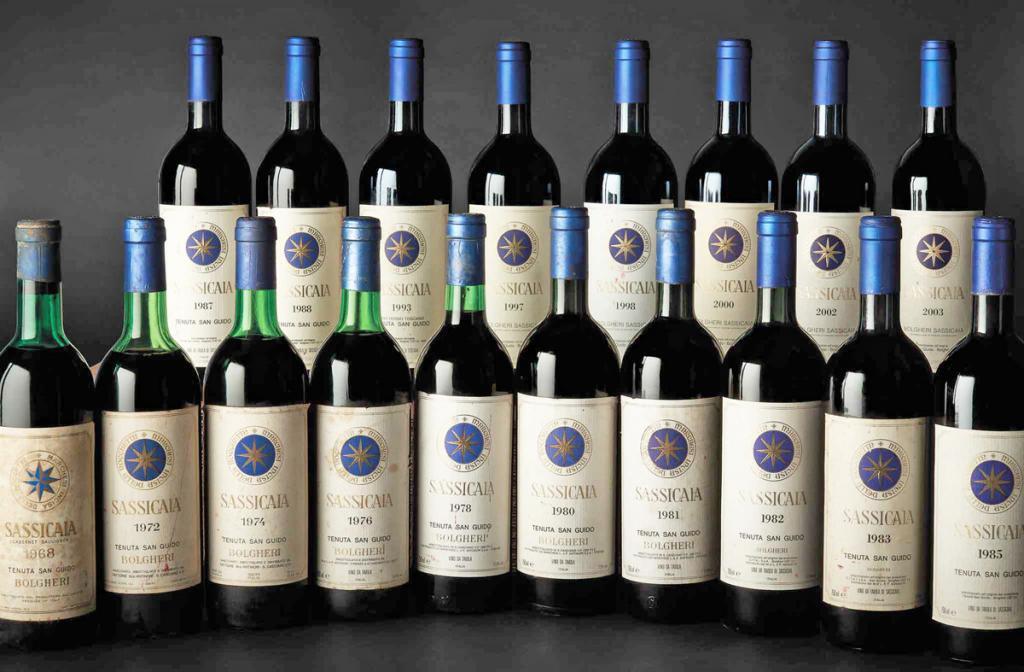What is a Super Tuscan?
To fully understand Sassicaia & Super Tuscan wines, we need to clarify the confusion surrounding the term. I’ll try to make it clear with a simple explanation. Many wines in Italy and Europe have an appellation. This means there are rules and requirements as to where a wine is made, how it’s made, and with which grape varietals. On the contrary, the only rules for a Super Tuscan are where the wine is made. The method and grape varietal are entirely free. There is however one unwritten rule which everyone adheres too. And that’s the concept that the wine must be of the highest quality. So in a nutshell, a Super Tuscan is a high quality wine that doesn’t follow any particular rules.
Sassicaia The World’s Most Famous Super Tuscan
Today there are numerous producers of Super Tuscan wines, but the story begins when Marquess Mario Incisa della Rocchetta married Marquess Clarice della Gherardesca in 1930. Her dowry included a 7,500-acre estate know as Tenuta San Guido. Today the estate is known as Sassicaia, after the world famous wine produced there.The estate is located near the small but pretty village of Bogheri on Tuscany’s south west coast.
Back in the day, the wines of Tuscany focused on light easy-drinking products to be consumed young. But the Marchese had different ideas. His desire was to re-create something in the style of Bordeaux reds, and story has it just for his own pleasure. So how did a wine made to keep one man happy, become the subject of legends?
Sassicaia Did Away With Tradition
So in 1944, della Rocchetta planted the San Guido estate’s first vineyard with Cabernet Sauvignon and Cabernet Franc. This was against the tradition of Italy’s finest wines, which traditionally featured native grapes such as Sangiovese and Nebbiolo.
The First Vintages Were Not a Success
Right up to the early 1960s, the wines were not released to the general public. The early vintages didn’t impress critics or consumers, who were more accustomed to the light local style. Consequently much of the production was consumed by the family or forgotten in the cellar. However when friends responded enthusiastically to a tasting of some of the estate’s older bottles, the Marquess found the inspiration to continue his project. In 1965, he planted a second vineyard, namely Sassicaia. The new vineyard produced the first vintage in 1968. The vintage was released on the market in 1971.
By the way the name Sassicaia means stony ground. The Sassicaia vineyard is planted on a 30-acre plot of gravelly soil and mirrors the Graves region of Bordeaux. (Graves also gains its name from its gravel rich soils.)
Enter The Marquess’s son
During the late 1960s and early 1970s, Nicoló Incisa, the Marquess’s son took an increasing role in the estate. He guided the San Guido Estate to international acclaim by adopting low vineyard yields, and more modern production methods. He also hired the acclaimed winemaker Giacomo Tachis.
The marquess senior used to age his wines in 225 liter Slovenian oak barrels. This was already a big change compared to the traditions of Tuscany where huge old casks were the norm. The wines that emerged were hard and tannic with great aging potential. It also meant they required extended periods in the bottle before they gave of their best.
Consequently starting with the 1977 vintage, Nicolò and Giacomo introduced French Tronçais oak barriques (also 225 liters in capacity) for aging. These gave a much better balance and drastically improved the quality at an earlier stage.
Sassicaia & Tignanello The Original Super Tuscans
In 1971 another tradition breaking wine was introduced on the market. It was produced by Nicolo’s cousin Piero Antinori and called Tignanello, which is the the name of the property in the Chianti wine district. Like Sassicaia, Tignanello is based on Cabernet Franc and Cabernet Sauvignon, and aged in French Oak barrels of 225 litres. Both these wines gained considerable international acclaim, but it wasn’t glory from the outset.
Sassicaia A Great Table Wine
Upon their introduction both Sassicaia and Tignanello could be labeled as table wine (Vino da Tavola). This because their grape varieties and barrel aging practices fell outside of the Italian appellations of DOC and DOCG.
Despite such lowly status, in 1978, a bottle of 1972 Sassicaia claimed the top spot in a blind tasting event against 30 Bordeaux blends from around the world. The victory gave the wine international recognition almost overnight.
It’s not entirely clear who coined the term “Super Tuscan,” but its believed to be a wine critic/journalist. Being so enthusiastic with the wines he had tasted, he described them as being “Super Tuscans” when they were still without an official designation. The name stuck.
Sassicaia’s & Tignanello’s Success Prompted a New Category
The fact that one of Italy’s finest wines could merely be labeled a table wine left the authorities with a dilemma. So finally in 1992, they introduced the Indicazione Geografica Tipica (IGT) classification. Unlike DOC and DOCG classifications, the IGT classification focuses on the wine’s region of origin, rather than grape varieties or wine styles
Sassicaia’s prestige was further acknowledged in 1994, when the San Guido estate was awarded its own appellation, Bolgheri Sassicaia DOC. The broader Bolgheri region became an official DOC around this time. If you want to find out more and maybe taste a few Super Tuscans for yourself, why not take a with me. Here’s my premium offering and I hope to hear from you.

